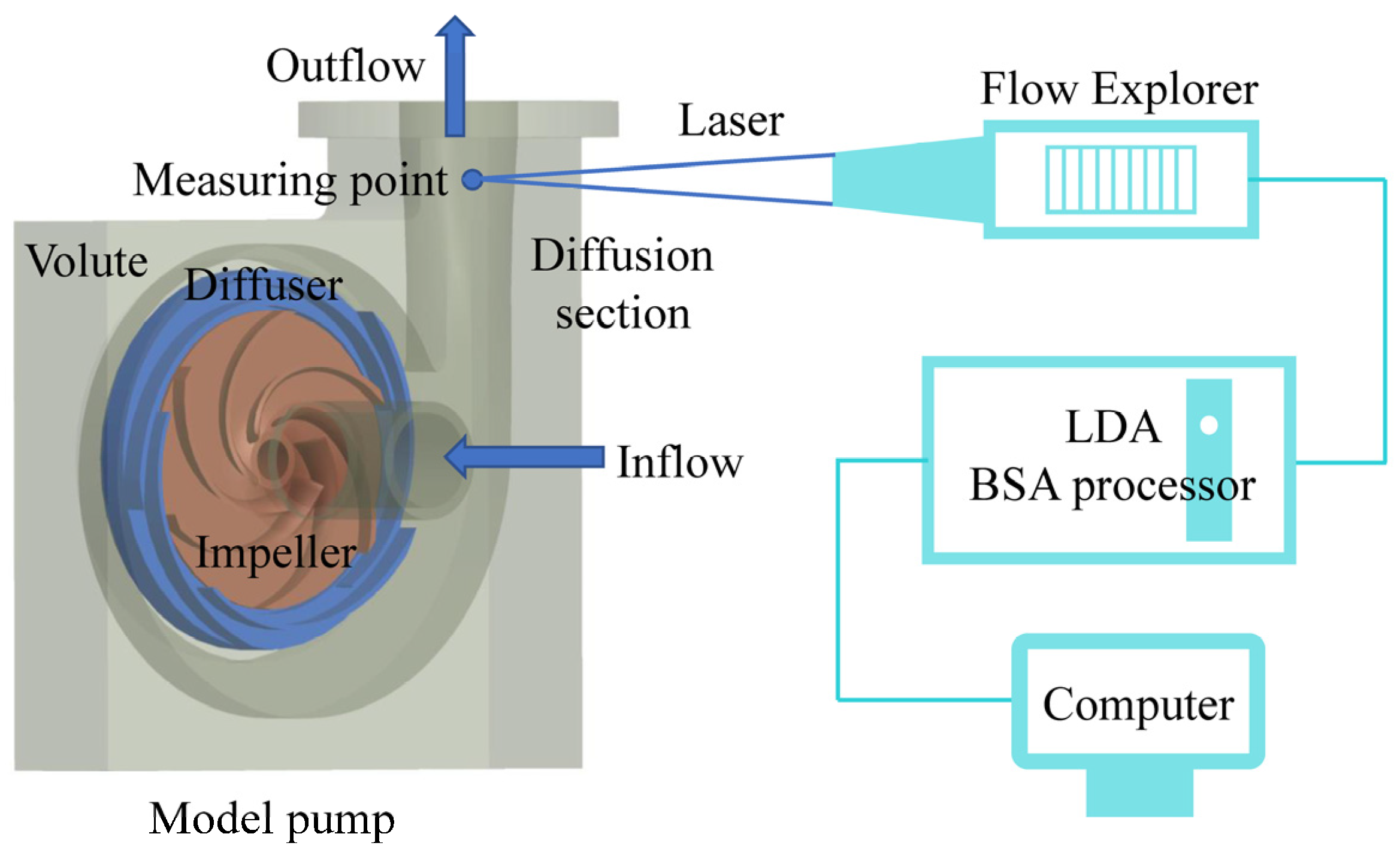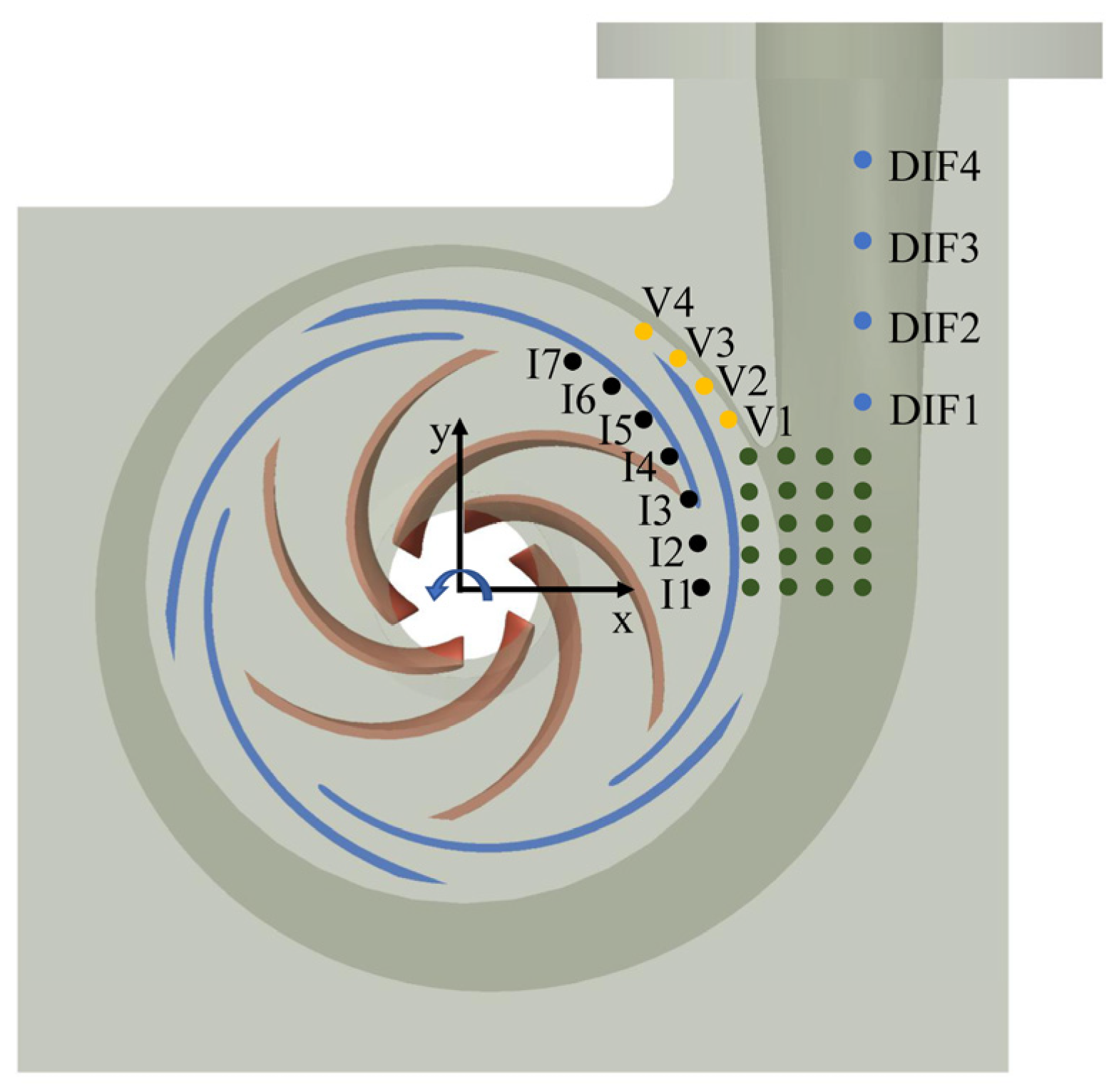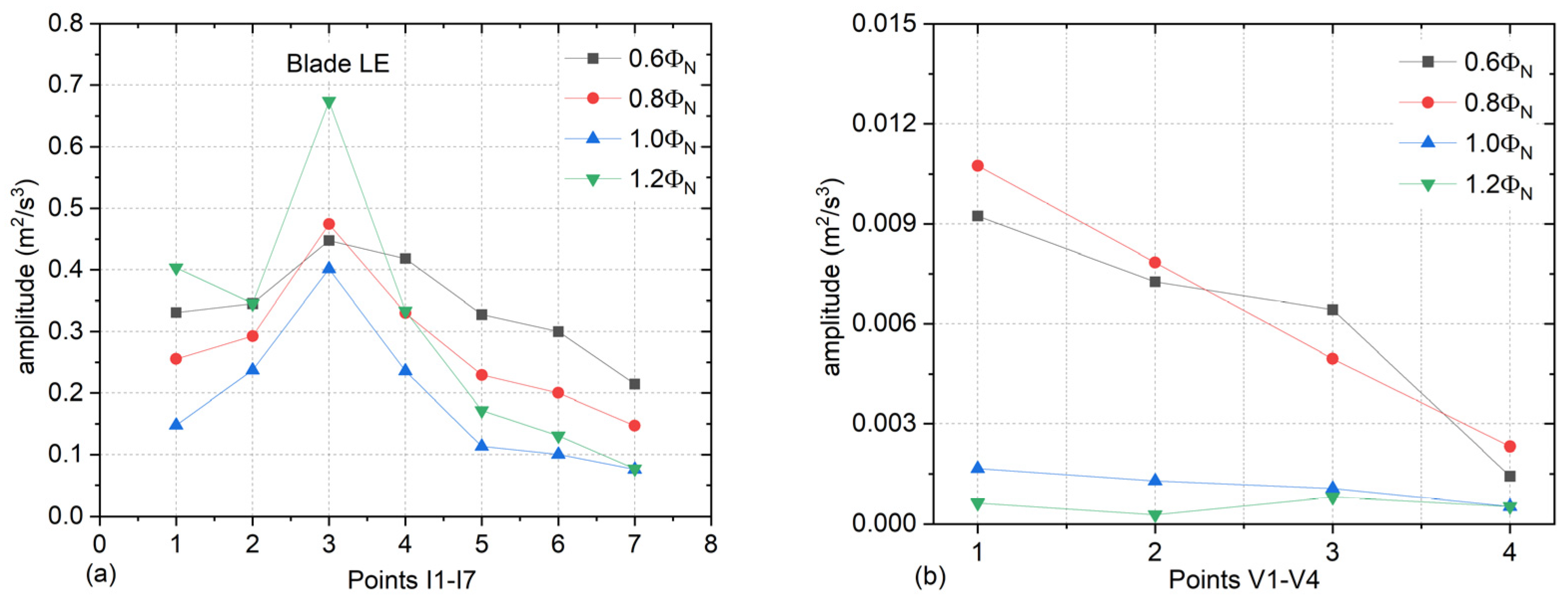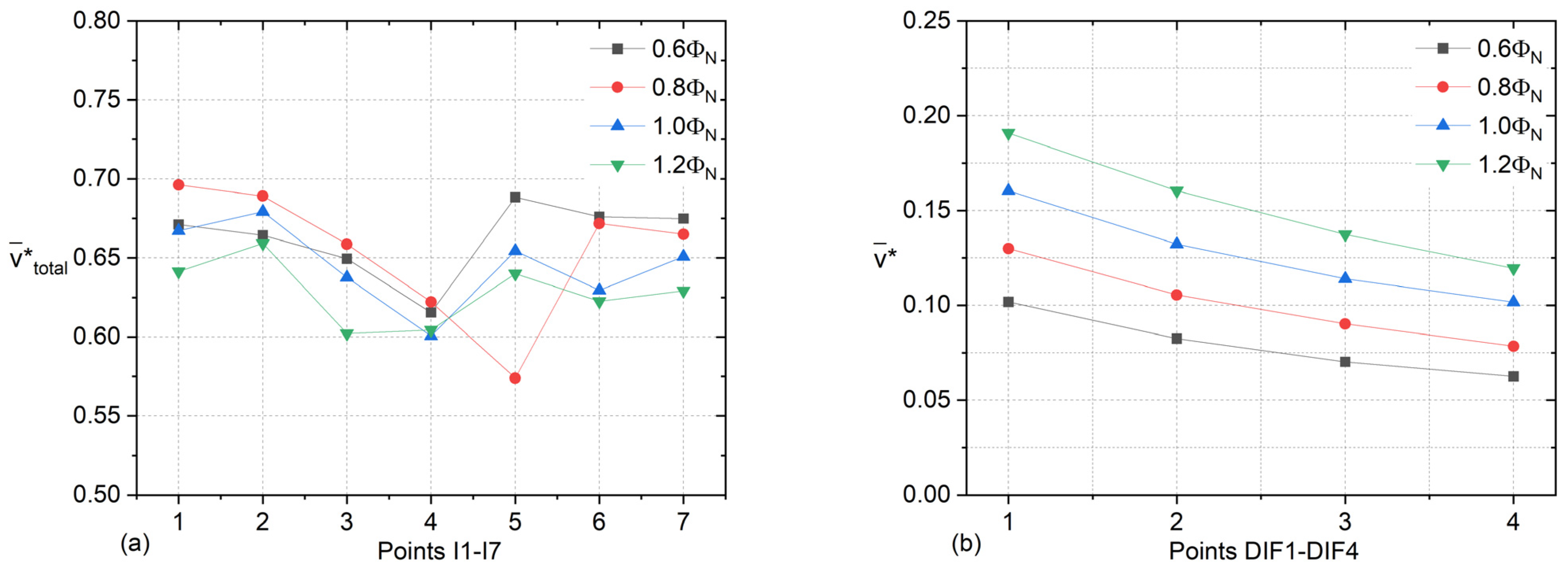Experimental Investigation on Velocity Fluctuation in a Vaned Diffuser Centrifugal Pump Measured by Laser Doppler Anemometry
Abstract
:1. Introduction
2. Experimental Setup of LDA Experiment
2.1. The Investigated Model Pump with a Vaned Diffuser
2.2. LDA Setup
3. Results and Discussions
3.1. Performance of the Model Pump
3.2. Velocity Fluctuations within the Model Pump
3.3. Reconstruction of Velocity Field
4. Conclusions
Author Contributions
Funding
Institutional Review Board Statement
Informed Consent Statement
Data Availability Statement
Conflicts of Interest
Nomenclature
| Qd | Rated pump capacity, m3/h |
| Hd | Rated pump head, m |
| nd | Rated rotating speed, r/min |
| ns | Specific speed |
| ΦN | Flow coefficient |
| ΨN | Head coefficient |
| Zr | Impeller blade number |
| Zs | Diffuser blade number |
| η | Efficiency |
| D1 | Impeller suction diameter, mm |
| D2 | Impeller exit diameter, mm |
| D3 | Diffuser outlet diameter |
| D4 | Volute exit diameter, mm |
| b2 | Impeller exit width, mm |
| b3 | Diffuser inlet width, mm |
| ϕ | Wrap angle, ° |
| u2 | Speed at the impeller exit, m/s |
| β2 | Blade exit angle, ° |
| β4 | Diffuser outlet angle, ° |
| ρ | Water density, m3/h |
| fn | Rotating frequency of the shaft, Hz |
| fBPF | Blade passing frequency of the rotor, Hz |
| v | Velocity magnitude, m/s |
| v* | Non-dimensional velocity |
| Mean velocity magnitude, m/s | |
| RMS | Root mean square of velocity, m/s |
| RMS* | Non-dimensional RMS |
| LE | Leading edge |
| RSI | Rotor-stator interaction |
| t | Measuring time, ms |
References
- Shankar, V.K.A.; Umashankar, S.; Paramasivam, S.; Hanigovszki, N. A comprehensive review on energy efficiency enhancement initiatives in centrifugal pumping system. Appl. Energy 2016, 181, 495–513. [Google Scholar] [CrossRef]
- Jiang, W.; Li, G.; Liu, P.F.; Fu, L. Numerical investigation of influence of the clocking effect on the unsteady pressure fluctuations and radial forces in the centrifugal pump with vaned diffuser. Int. Commun. Heat Mass Transf. 2016, 71, 164–171. [Google Scholar] [CrossRef]
- Barrio, R.; Fernandez, J.; Blanco, E.; Parrondo, J. Estimation of radial load in centrifugal pumps using computational fluid dynamics. Eur. J. Mech. B Fluids 2011, 30, 316–324. [Google Scholar] [CrossRef]
- Posa, A.; Lippolis, A. A LES investigation of off-design performance of a centrifugal pump with variable-geometry diffuser. Int. J. Heat Fluid Flow 2018, 70, 299–314. [Google Scholar] [CrossRef]
- Lu, Y.G.; Zhu, R.S.; Wang, X.L.; Wang, Y.; Fu, Q.; Ye, D.X. Study on the complete rotational characteristic of coolant pump in the gas-liquid two-phase operating condition. Ann. Nucl. Energy 2019, 123, 180–189. [Google Scholar]
- Long, Y.; An, C.; Zhu, R.S.; Chen, J.P. Research on hydrodynamics of high velocity regions in a water-jet pump based on experimental and numerical calculations at different cavitation conditions. Phys. Fluids 2021, 33, 045124. [Google Scholar] [CrossRef]
- Gao, B.; Guo, P.M.; Zhang, N.; Li, Z.; Ni, D. Unsteady Pressure pulsation measurements and analysis of a low specific speed centrifugal pump. ASME J. Fluids Eng. 2017, 139, 071101. [Google Scholar] [CrossRef]
- Wang, W.; Pei, J.; Yuan, S.; Yin, T. Experimental investigation on clocking effect of vaned diffuser on performance characteristics and pressure pulsations in a centrifugal pump. Exp. Therm. Fluid Sci. 2018, 90, 286–298. [Google Scholar] [CrossRef]
- Ni, D.; Zhang, N.; Gao, B.; Li, Z.; Yang, M.G. Dynamic measurements on unsteady pressure pulsations and flow distributions in a nuclear reactor coolant pump. Energy 2020, 198, 117305. [Google Scholar] [CrossRef]
- Yang, S.S.; Liu, H.L.; Kong, F.Y.; Xia, B.; Tan, L.W. Effects of the radial gap between impeller tips and volute tongue influencing the performance and pressure pulsations of pump as turbine. ASME J. Fluids Eng. 2014, 136, 054501. [Google Scholar] [CrossRef]
- Zeng, Y.S.; Yao, Z.F.; Wang, F.J.; Xiao, R.F.; He, C.L. Experimental investigation on pressure fluctuation reduction in a double suction centrifugal pump: Influence of impeller stagger and blade geometry. ASME J. Fluids Eng. 2020, 142, 041202. [Google Scholar] [CrossRef]
- Gao, B.; Zhang, N.; Li, Z.; Ni, D.; Yang, M.G. Influence of the blade trailing edge profile on the performance and unsteady pressure pulsations in a low specific speed centrifugal pump. ASME J. Fluids Eng. 2016, 138, 051106. [Google Scholar] [CrossRef]
- Zhang, J.; Li, G.; Mao, J.; Yuan, S.; Qu, Y.; Jia, J. Numerical investigation of the effects of splitter blade deflection on the pressure pulsation in a low specific speed centrifugal pump. Proc. Inst. Mech. Eng. Part A 2019, 234, 420–432. [Google Scholar] [CrossRef]
- Zhang, N.; Yang, M.G.; Gao, B.; Li, Z.; Ni, D. Experimental investigation on unsteady pressure pulsation in a centrifugal pump with special slope volute. ASME J. Fluids Eng. 2015, 137, 061103. [Google Scholar] [CrossRef]
- Posa, A.; Lippolis, A.; Balaras, E. Investigation of separation phenomena in a radial pump at reduced flow rate by large-eddy simulation. ASME J. Fluids Eng. 2016, 138, 121101. [Google Scholar] [CrossRef] [Green Version]
- Posa, A.; Lippolis, A. Effect of working conditions and diffuser setting angle on pressure fluctuations within a centrifugal pump. Int. J. Heat Fluid Flow 2019, 75, 44–60. [Google Scholar] [CrossRef]
- Kye, B.; Park, K.; Choi, H.; Lee, M.; Kim, J.H. Flow characteristics in a volute type centrifugal pump using large eddy simulation. Int. J. Heat Fluid Flow 2018, 72, 52–60. [Google Scholar] [CrossRef]
- Zhang, N.; Liu, X.; Gao, B.; Xia, B. DDES analysis of the unsteady wake flow and its evolution of a centrifugal pump. Renew. Energy 2019, 141, 570–582. [Google Scholar] [CrossRef]
- Zhang, N.; Jiang, J.; Gao, B.; Liu, X.; Ni, D. Numerical analysis of the vortical structure and its unsteady evolution of a centrifugal pump. Renew. Energy 2020, 155, 748–760. [Google Scholar] [CrossRef]
- Keller, J.; Blanco, E.; Barrio, R.; Parrondo, J. PIV measurements of the unsteady flow structures in a volute centrifugal pump at a high flow rate. Exp. Fluids 2014, 55, 1820. [Google Scholar] [CrossRef]
- Zhang, N.; Gao, B.; Li, Z.; Ni, D.; Jiang, Q.F. Unsteady flow structure and its evolution in a low specific speed centrifugal pump measured by PIV. Exp. Therm. Fluid Sci. 2018, 97, 133–144. [Google Scholar] [CrossRef]
- Feng, J.J.; Benra, F.K.; Dohmen, H.J. Investigation of periodically unsteady flow in a radial pump by CFD simulations and LDV measurements. ASME J. Turbomach. 2011, 133, 011004. [Google Scholar] [CrossRef]
- Pedersen, N.; Larsen, P.S.; Jacobsen, C.B. Flow in a centrifugal pump impeller at design and off-design conditions—Part I: Particle image velocimetry (PIV) and laser Doppler velocimetry (LDV) measurements. ASME J. Fluids Eng. 2003, 125, 61–72. [Google Scholar] [CrossRef]
- Wuibaut, G.; Bois, G.; Hajem, M.E.; Akhras, A.; Champagne, J.Y. Optical PIV and LDV comparisons of internal flow investigations in SHF impeller. Int. J. Rotating Mach. 2006, 20006, 069521. [Google Scholar] [CrossRef] [Green Version]
- Zhang, N.; Zheng, F.K.; Liu, X.K.; Gao, B.; Li, G. Unsteady flow fluctuations in a centrifugal pump measured by laser Doppler anemometry and pressure pulsation. Phys. Fluids 2020, 32, 125108. [Google Scholar] [CrossRef]
- Zhang, N.; Gao, B.; Ni, D.; Liu, X. Coherence analysis to detect unsteady rotating stall phenomenon based on pressure pulsation signals of a centrifugal pump. Mech. Syst. Signal Process. 2021, 148, 107161. [Google Scholar] [CrossRef]
- Dantec Dynamics. BSA Flow Software Users Guide; Dantec Dynamics: Skovlunde, Denmark, 2019. [Google Scholar]
- Zhang, N.; Gao, B.; Xia, B.; Jiang, Q.F. Effect of the volute tongue cut on pressure pulsations of a low specific speed centrifugal pump. J. Hydrodyn. 2020, 32, 758–770. [Google Scholar] [CrossRef]
- Posa, A. LES investigation on the dependence of the flow through a centrifugal pump on the diffuser geometry. Int. J. Heat Fluid Flow 2021, 87, 108750. [Google Scholar] [CrossRef]
- Zhang, F.; Adu-Poku, K.A.; Hu, B.; Appiah, D.; Chen, K. Flow theory in the side chambers of the radial pumps: A review. Phys. Fluids 2020, 33, 041301. [Google Scholar]
- Zhang, Z.C.; Chen, H.X.; Yin, J.L.; Ma, Z.; Gu, Q.; Lu, J.Q.; Liu, H. Unsteady flow characteristics in centrifugal pump based on proper orthogonal decomposition method. Phys. Fluids 2021, 33, 075122. [Google Scholar] [CrossRef]
- Long, Y.; Lin, B.; Fang, J.; Zhu, R.S.; Fu, Q. Research on the transient hydraulic characteristics of multistage centrifugal pump during start-up process. Front. Energy Res. 2020, 8, 00076. [Google Scholar] [CrossRef]
- Li, D.; Zhang, N.; Jiang, J.; Gao, B.; Alubokin, A.A.; Zhou, W.; Shi, J. Numerical investigation on the unsteady vortical structure and pressure pulsations of a centrifugal pump with the vaned diffuser. Int. J. Heat Fluid Flow 2022, 98, 109050. [Google Scholar] [CrossRef]
- Zhang, N.; Li, D.L.; Gao, B.; Ni, D.; Li, Z. Unsteady pressure pulsations in pumps—A review. Energies 2023, 16, 150. [Google Scholar] [CrossRef]
















| Parameters | Value |
|---|---|
| Flow rate Qd | 55 m3/h |
| Head Hd | 20 m |
| Rotation speed nd | 1450 r/min |
| Specific speed | 69 |
| Blade number Zr | 6 |
| Diffuser blade number Zs | 5 |
| Impeller suction diameter D1 | 80 mm |
| Impeller exit diameter D2 | 250 mm |
| Volute exit diameter D4 | 100 mm |
| Impeller exit angle β2 | 25° |
| Impeller wrap angle ϕ | 125° |
| Diffuser inlet width b3 | 21 mm |
| Diffuser outlet diameter D3 | 320 mm |
| Diffuser outlet angle β4 | 17° |
| Speed at the impeller exit u2 | 18.9 m/s |
| Rotating frequency fn | 24.2 Hz |
| Blade passing frequency fBPF | 145 Hz |
Disclaimer/Publisher’s Note: The statements, opinions and data contained in all publications are solely those of the individual author(s) and contributor(s) and not of MDPI and/or the editor(s). MDPI and/or the editor(s) disclaim responsibility for any injury to people or property resulting from any ideas, methods, instructions or products referred to in the content. |
© 2023 by the authors. Licensee MDPI, Basel, Switzerland. This article is an open access article distributed under the terms and conditions of the Creative Commons Attribution (CC BY) license (https://creativecommons.org/licenses/by/4.0/).
Share and Cite
Zhang, N.; Li, D.; Jiang, J.; Gao, B.; Ni, D.; Alubokin, A.A.; Zhang, W. Experimental Investigation on Velocity Fluctuation in a Vaned Diffuser Centrifugal Pump Measured by Laser Doppler Anemometry. Energies 2023, 16, 3223. https://doi.org/10.3390/en16073223
Zhang N, Li D, Jiang J, Gao B, Ni D, Alubokin AA, Zhang W. Experimental Investigation on Velocity Fluctuation in a Vaned Diffuser Centrifugal Pump Measured by Laser Doppler Anemometry. Energies. 2023; 16(7):3223. https://doi.org/10.3390/en16073223
Chicago/Turabian StyleZhang, Ning, Delin Li, Junxian Jiang, Bo Gao, Dan Ni, Anthony Akurugo Alubokin, and Wenbin Zhang. 2023. "Experimental Investigation on Velocity Fluctuation in a Vaned Diffuser Centrifugal Pump Measured by Laser Doppler Anemometry" Energies 16, no. 7: 3223. https://doi.org/10.3390/en16073223





